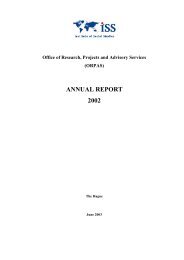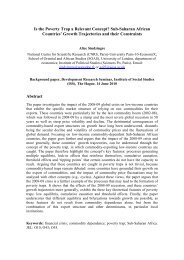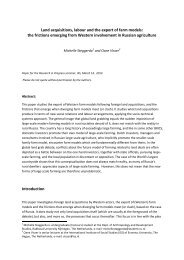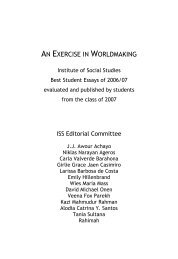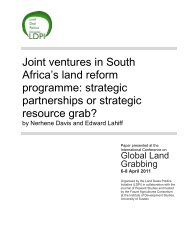AN EXERCISE IN WORLDMAKING 2009 - ISS
AN EXERCISE IN WORLDMAKING 2009 - ISS
AN EXERCISE IN WORLDMAKING 2009 - ISS
Create successful ePaper yourself
Turn your PDF publications into a flip-book with our unique Google optimized e-Paper software.
16 What’s Yours is Mine 193<br />
the day of her marriage’. This (assumed direct quote) from him confirms<br />
insulting presumptions that disadvantage persons – particularly oppressed<br />
Muslim women – do not experience joy. Further details report<br />
that Gula remembers being married at 13, which the husband disputes as<br />
16. So far, Gula is defined solely by relationships and remains mute.<br />
Some attributed roles are contradictory, such as that of mother enjoying<br />
her children and violent Pashtun with searing eyes.<br />
Finally, Islamic dress comes into question via Yusufzai, explaining<br />
Gula’s entry into purdah at age 13, explained by the author as secluded<br />
existence instead of systematized modesty: ‘Women vanish from the<br />
eye.’ ‘Vanish’ engages Orientalist discourse whereby women apparently<br />
cease to ‘exist’ in contrast with the visibility of female body exposure in<br />
Western society. For the first time in the article, Gula herself is directly<br />
quoted: ‘[burqa] is a beautiful thing to wear, not a curse.’ Ignoring that<br />
statement, in the next sentence she is described with constructed inner<br />
dialogue, ‘Faced by questions, she retreats into the black shawl wrapped<br />
around her face, as if by doing so she might will herself to evaporate.’<br />
She states that her hijab is positive, and it is portrayed as something under<br />
which she hides and vanishes.<br />
Culture is implicitly addressed, ‘The eyes flash anger. It is not her custom<br />
to subject herself to the questions of strangers.’ Despite it not being<br />
‘custom’ to be without burqa in front of unrelated males, photographs of<br />
her face are viewed by millions of readers. The author chooses not to<br />
discuss this, nor the dynamics of how Gula’s unveiling is orchestrated in<br />
the presence of McCurry, translators and other male members of the<br />
EXPLORER, dismissing her attachment to hijab. The author perpetuates<br />
a dehumanizing tone, choosing to write ‘the eyes,’ not ‘her eyes.’<br />
Gula is asked, ‘Had she ever felt safe?’ to which she answers, ‘No. But<br />
life under the Taliban was better. At least there was peace and order.’<br />
Profoundly disturbing is the lack of unpacking this statement. Gula is<br />
not asked why she feels this way, nor her reasoning. Instead the story<br />
quickly shifts to education, Gula’s lack of it, remorse about leaving<br />
school and her hopes of education for her daughters. The author writes,<br />
‘Education is the light in the eye. There is no such light for her.’ By making<br />
grand claims of Gula’s lack of light, as well as equating light solely<br />
with book-learning and not life experience, ontological assumptions of<br />
her ignorance are made. This claim, paired with descriptions of her allegedly<br />
wanting to disappear into hijab and the failure to unpack her state-




